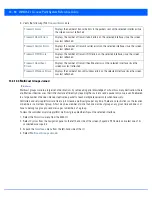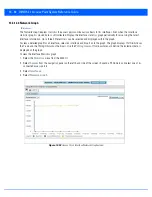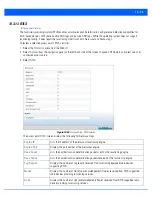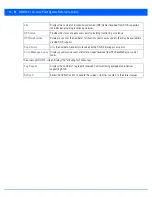
13 - 100 WiNG 5.7.1 Access Point System Reference Guide
13.3.15.2 OSPF Neighbors
OSPF establishes neighbor relationships to exchange routing updates with other routers. An access point supporting OSPF
sends hello packets to discover neighbors and elect a designated router. The hello packet includes link state information and
list of neighbors. OSPF is savvy with layer 2 topologies. If on a point-to-point link, OSPF knows it is sufficient, and the link stays
up. If on a broadcast link, the router waits for election before determining if the link is functional.
To view OSPF neighbor statistics:
1. Select the
Statistics
menu from the Web UI.
2. Select
System
from the navigation pane (on the left-hand side of the screen), expand the default node and select an access
point for statistical observation.
3. Select
OSPF
.
4. Select the
Neighbor Info
tab.
Figure 13-57
Access Point - OSPF Neighbor Info tab
The
Neighbor Info
tab describes the following:
Router ID
Displays the router ID assigned for this OSPF connection. The router is a level three Internet
Protocol packet switch. This ID must be established in every OSPF instance. If not explicitly
configured, the highest logical IP address is duplicated as the router identifier. However, since the
router identifier is not an IP address, it does not have to be a part of any routable subnet in the
network.
Neighbor Priority
Displays each listed neighbor’s priority in respect to becoming the designated router managing the
OSPF connection. The designated router is the router interface elected among all routers on a
particular multi-access network segment.
IF Name
Lists the name assigned to the router interface used to support connections amongst OSPF enabled
neighbors.
Neighbor
Address
Lists the IP address of the neighbor sharing the router interface with each listed router ID.
Summary of Contents for WiNG 5.7.1
Page 1: ...WiNG 5 7 1 ACCESS POINT SYSTEM REFERENCE GUIDE ...
Page 2: ......
Page 3: ...WING 5 7 1 ACCESS POINT SYSTEM REFERENCE GUIDE MN001977A01 Revision A April 2015 ...
Page 4: ...ii WiNG 5 7 1 Access Point System Reference Guide ...
Page 24: ...1 4 WiNG 5 7 1 Access Point System Reference Guide ...
Page 36: ...2 12 WiNG 5 7 1 Access Point System Reference Guide ...
Page 72: ...3 36 WiNG 5 7 1 Access Point System Reference Guide ...
Page 470: ...5 386 WiNG 5 7 1 Access Point System Reference Guide ...
Page 472: ...6 2 WiNG 5 7 1 Access Point System Reference Guide Figure 6 1 Configuration Wireless menu ...
Page 624: ...7 46 WiNG 5 7 1 Access Point System Reference Guide ...
Page 724: ...9 56 WiNG 5 7 1 Access Point System Reference Guide ...
Page 783: ...12 35 Figure 12 46 Device Summary screen 4 Click File Management ...
Page 816: ...12 68 WiNG 5 7 1 Access Point System Reference Guide ...
Page 1006: ...13 190 WiNG 5 7 1 Access Point System Reference Guide ...
Page 1026: ...14 20 WiNG 5 7 1 Access Point System Reference Guide ...
Page 1028: ...A 2 WiNG 5 7 1 Access Point System Reference Guide ...
Page 1089: ......
Page 1090: ...MN001977A01 Revision A April 2015 ...
















































